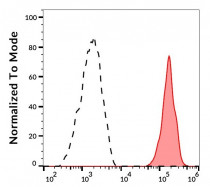ARG62727
anti-CD14 antibody [B-A8]
anti-CD14 antibody [B-A8] for ELISA,Flow cytometry,ICC/IF,IHC-Formalin-fixed paraffin-embedded sections and Human
Developmental Biology antibody; Immune System antibody; General Lymphocyte Marker Study antibody; Macrophages and neutrophils antibody
Overview
| Product Description | Mouse Monoclonal antibody [B-A8] recognizes CD14 |
|---|---|
| Tested Reactivity | Hu |
| Tested Application | ELISA, FACS, ICC/IF, IHC-P |
| Specificity | The clone B-A8 reacts with CD14, a 53-55 kDa GPI (glycosylphosphatidylinositol)-linked membrane glycoprotein expressed on monocytes, macrophages and weakly on granulocytes; also expressed by most tissue macrophages. |
| Host | Mouse |
| Clonality | Monoclonal |
| Clone | B-A8 |
| Isotype | IgG1 |
| Target Name | CD14 |
| Antigen Species | Human |
| Immunogen | Human monocytes |
| Conjugation | Un-conjugated |
| Alternate Names | CD antigen CD14; Myeloid cell-specific leucine-rich glycoprotein; Monocyte differentiation antigen CD14 |
Application Instructions
| Application Suggestion |
|
||||||||||
|---|---|---|---|---|---|---|---|---|---|---|---|
| Application Note | ELISA: The clone B-A8 has been tested as the capture antibody in a sandwich ELISA for analysis of human CD14 in combination with antibody MEM-18 (ARG62725). IHC-P: Heat retrieval of antigen is recommeded. Staining on human PML brain sections was mainly observed on monocytes in the lumenal side of brain blood vessels, and on some perivascular cells adjacent to medium-sized vessels. * The dilutions indicate recommended starting dilutions and the optimal dilutions or concentrations should be determined by the scientist. |
||||||||||
| Positive Control | IHC-P: PML brain section |
Properties
| Form | Liquid |
|---|---|
| Purification | Purified by protein A |
| Purity | > 95% (by SDS-PAGE) |
| Buffer | PBS (pH 7.4) and 15 mM Sodium azide |
| Preservative | 15 mM Sodium azide |
| Concentration | 1 mg/ml |
| Storage Instruction | For continuous use, store undiluted antibody at 2-8°C for up to a week. For long-term storage, aliquot and store at -20°C or below. Storage in frost free freezers is not recommended. Avoid repeated freeze/thaw cycles. Suggest spin the vial prior to opening. The antibody solution should be gently mixed before use. |
| Note | For laboratory research only, not for drug, diagnostic or other use. |
Bioinformation
| Database Links |
Swiss-port # P08571 Human Monocyte differentiation antigen CD14 |
|---|---|
| Gene Symbol | CD14 |
| Gene Full Name | CD14 molecule |
| Background | CD14 is a 55 kDa GPI-anchored glycoprotein, constitutively expressed on the surface of mature monocytes, macrophages, and neutrophils, where serves as a multifunctional lipopolysaccharide receptor; it is also released to the serum both as a secreted and enzymatically cleaved GPI-anchored form. CD14 binds lipopolysaccharide molecule in a reaction catalyzed by lipopolysaccharide-binding protein (LBP), an acute phase serum protein. The soluble sCD14 is able to discriminate slight structural differences between lipopolysaccharides and is important for neutralization of serum allochthonous lipopolysaccharides by reconstituted lipoprotein particles. CD14 affects allergic, inflammatory and infectious processes. |
| Function | In concert with LBP, binds to monomeric lipopolysaccharide and delivers it to the MD-2/TLR4 complex, thereby mediating the innate immune response to bacterial lipopolysaccharide (LPS). Acts via MyD88, TIRAP and TRAF6, leading to NF-kappa-B activation, cytokine secretion and the inflammatory response. Up-regulates cell surface molecules, including adhesion molecules. [UniProt] |
| Research Area | Developmental Biology antibody; Immune System antibody; General Lymphocyte Marker Study antibody; Macrophages and neutrophils antibody |
| Calculated MW | 40 kDa |
| PTM | N- and O- glycosylated. O-glycosylated with a core 1 or possibly core 8 glycan. |
Images (1) Click the Picture to Zoom In
Clone References








